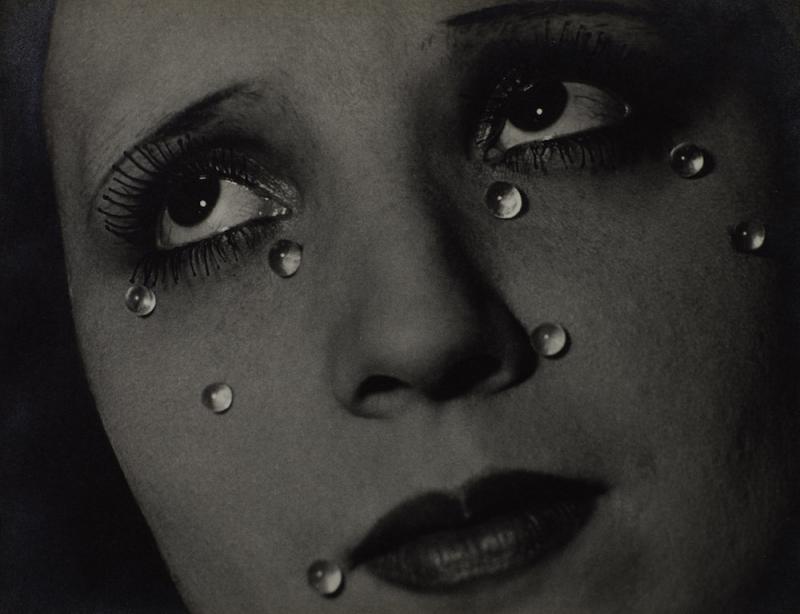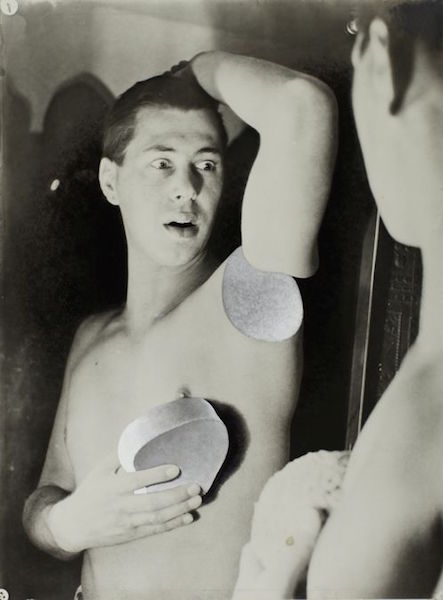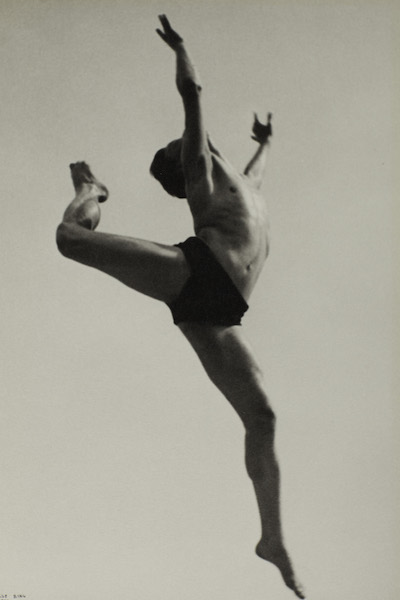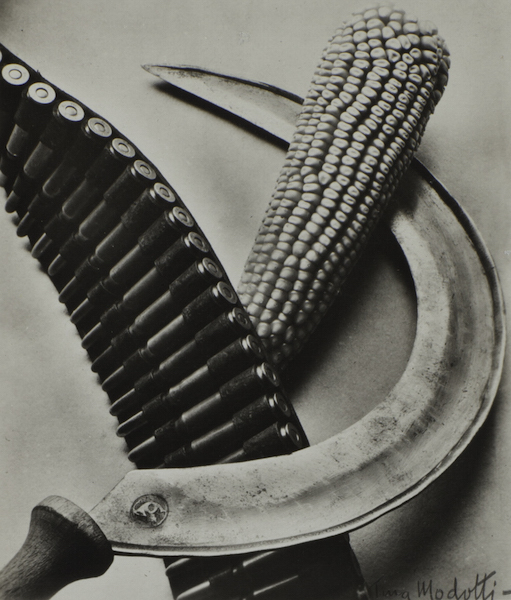The Radical Eye, Tate Modern | reviews, news & interviews
The Radical Eye, Tate Modern
The Radical Eye, Tate Modern
The passion of Elton John: a first-class collection in private hands

“For me photography is a journey of discovery”, says Elton John. “I buy what I like and if it's not fashionable I don’t care. The more you collect, the more sophisticated your eye becomes.” He realised he had become a serious collector when, in 1993, he paid a record price at auction for Glass Tears, 1932 by Man Ray (main picture).
“That image stayed with me from the time I first saw it,” recalls John. “I thought I had gone stark raving mad but I had to have it.” Collecting had become an obsession; he was hooked. The Radical Eye, a selection of 200 photographs from his collection, attests to the quality of the pictures he has acquired over the last 25 years.
 It all began in 1990 when, having conquered his dependence on alcohol, John emerged from rehab and needed something on which to focus his attention. He went to France to stay with friends who were organising a photography festival in Cahors, where he met the photographer Herb Ritts and dealer David Fahey and bought his first photographs.
It all began in 1990 when, having conquered his dependence on alcohol, John emerged from rehab and needed something on which to focus his attention. He went to France to stay with friends who were organising a photography festival in Cahors, where he met the photographer Herb Ritts and dealer David Fahey and bought his first photographs.
Soon he discovered there was more to photography than pictures of beautiful or famous people and began seeking advice from dealers like Jane Jackson, who later became Director of his collection. The timing was right. Because the medium was still considered a minor art form by many and collectors were few on the ground, he was able to acquire vintage prints by artists such as Man Ray, Herbert Bayer and André Kertész and amass a collection reflecting the history of 20th century photography that features many of the experimental images that changed our perceptions of the world.
This matters to us because, having ignored the medium until 2009, the Tate owns no photographs by these modernist pioneers (fortunately the V&A was not so myopic), so we are incredibly lucky that John has agreed to share his collection with us. And what a treat!
 The show opens with a portrait of John taken by Irving Penn in 1997, whose distortions make him look like a deranged Alan Bennett. Several other portraits by Penn show famous sitters tucked into a tight corner in his studio. Slumped low in a chair, boxer Joe Louis (1948) seems like a deflated bag of bones; Salvador Dali (1947), on the other hand, (pictured above right) looks ready to take on the world as he poses in a dapper black suit, elbows out and legs spread assertively apart.
The show opens with a portrait of John taken by Irving Penn in 1997, whose distortions make him look like a deranged Alan Bennett. Several other portraits by Penn show famous sitters tucked into a tight corner in his studio. Slumped low in a chair, boxer Joe Louis (1948) seems like a deflated bag of bones; Salvador Dali (1947), on the other hand, (pictured above right) looks ready to take on the world as he poses in a dapper black suit, elbows out and legs spread assertively apart.
Masks were an ongoing source of fascination for the Surrealists and they feature large in the exhibition. In Man Ray’s portrait of her from 1921, Berenice Abbott cups her head in her hands as though it were a delicate mask detached from her body. In Noire et Blanche, 1926, he juxtaposes a model’s head with a black ebony mask; the image is paired with a negative print, which turns the model’s face black and the mask white to create a complex visual dialogue about tonal variations, the beauty of monochrome and the difference between an inanimate object and a living being.
In Norman Parkinson’s 1938 portrait, Edward James poses, eyes closed, beside an item from his collection of surrealist art – a death mask of Napoleon painted with clouds by René Magritte. Lit dramatically from below, the two heads – one plaster, the other living flesh – look equally pallid and sepulchral.
 Actress Gloria Swanson, in 1924, looks like a panther trapped behind the black lace thrown across her face by Edward Steichen. The Parisian fireman encountered by Josef Breitenbach in 1935 needed no additional props to make him appear strange: encased in a heavy breathing apparatus, he looks like a robot impersonating a human.
Actress Gloria Swanson, in 1924, looks like a panther trapped behind the black lace thrown across her face by Edward Steichen. The Parisian fireman encountered by Josef Breitenbach in 1935 needed no additional props to make him appear strange: encased in a heavy breathing apparatus, he looks like a robot impersonating a human.
Herbert Bayer portrays himself, in 1932, (pictured above left) as a mannequin with a slice cut out of his left arm; the optical trickery is further complicated by the fact that we are looking over his shoulder at his reflection in a mirror.
If portraits were the perfect vehicle for an exploration of the truth of the photographic image, nudes like Edward Weston’s 1936 Nude provided an opportunity to portray the body as a sculptural object, a beautiful collection of interlocking solids, or as in Ilse Bing’s Dancer, Willem van Loon, 1932 (pictured above right), a dynamic force overcoming gravity.
The still-life provided an opportunity to explore positive and negative space, texture, pattern, light and dark contrast, and scale; this may sound dryly academic, but in the hands of artists like Herbert Bayer, Paul Strand, Imogen Cunningham and André Kertész, led to some exquisite visual poetry. In her Bandolier, Corn and Sickle, 1927 (pictured above left), Mexican photographer Tina Modotti transforms the objects into symbols of revolutionary struggle. Photographing buildings provided Berenice Abbott, Margaret Bourke-White and Alexander Rodchenko with a chance to explore unusual vantage points and extreme perspectives.
 John’s collection includes examples of all these initiatives, but is weighted in favour of American photography and so has some striking omissions. Norman Parkinson is the only Brit in the exhibition; Alvin Langdon Coburn, Bill Brandt and Angus McBean being obvious candidates for inclusion. The Russians, Germans and French are also under-represented; El Lissitzky is missing and Alexander Rodchenko appears only twice. August Sander, Lyonel Feininger, Hannah Höch, Raoul Hausmann and John Heartfield are absent, while László Moholy-Nagy appears with only a single work. Florence Henri, Claude Cahun and Brassaï are also missing.
John’s collection includes examples of all these initiatives, but is weighted in favour of American photography and so has some striking omissions. Norman Parkinson is the only Brit in the exhibition; Alvin Langdon Coburn, Bill Brandt and Angus McBean being obvious candidates for inclusion. The Russians, Germans and French are also under-represented; El Lissitzky is missing and Alexander Rodchenko appears only twice. August Sander, Lyonel Feininger, Hannah Höch, Raoul Hausmann and John Heartfield are absent, while László Moholy-Nagy appears with only a single work. Florence Henri, Claude Cahun and Brassaï are also missing.
Elton John can buy whatever he likes, of course, but while his collection gives a splendid overview of the photographic experiments begun 100 years ago, it is worth remembering that the view of history it presents is skewed. It would be fun to curate a European-weighted show of work from the same period.
rating
Buy
Explore topics
Share this article
The future of Arts Journalism
You can stop theartsdesk.com closing!
We urgently need financing to survive. Our fundraising drive has thus far raised £49,000 but we need to reach £100,000 or we will be forced to close. Please contribute here: https://gofund.me/c3f6033d
And if you can forward this information to anyone who might assist, we’d be grateful.

Subscribe to theartsdesk.com
Thank you for continuing to read our work on theartsdesk.com. For unlimited access to every article in its entirety, including our archive of more than 15,000 pieces, we're asking for £5 per month or £40 per year. We feel it's a very good deal, and hope you do too.
To take a subscription now simply click here.
And if you're looking for that extra gift for a friend or family member, why not treat them to a theartsdesk.com gift subscription?
more Visual arts
 'We are bowled over!' Thank you for your messages of love and support
Much-appreciated words of commendation from readers and the cultural community
'We are bowled over!' Thank you for your messages of love and support
Much-appreciated words of commendation from readers and the cultural community
![SEX MONEY RACE RELIGION [2016] by Gilbert and George. Installation shot of Gilbert & George 21ST CENTURY PICTURES Hayward Gallery](https://theartsdesk.com/sites/default/files/styles/thumbnail/public/mastimages/Gilbert%20%26%20George_%2021ST%20CENTURY%20PICTURES.%20SEX%20MONEY%20RACE%20RELIGION%20%5B2016%5D.%20Photo_%20Mark%20Blower.%20Courtesy%20of%20the%20Gilbert%20%26%20George%20and%20the%20Hayward%20Gallery._0.jpg?itok=7tVsLyR-) Gilbert & George, 21st Century Pictures, Hayward Gallery review - brash, bright and not so beautiful
The couple's coloured photomontages shout louder than ever, causing sensory overload
Gilbert & George, 21st Century Pictures, Hayward Gallery review - brash, bright and not so beautiful
The couple's coloured photomontages shout louder than ever, causing sensory overload
 Lee Miller, Tate Britain review - an extraordinary career that remains an enigma
Fashion photographer, artist or war reporter; will the real Lee Miller please step forward?
Lee Miller, Tate Britain review - an extraordinary career that remains an enigma
Fashion photographer, artist or war reporter; will the real Lee Miller please step forward?
 Kerry James Marshall: The Histories, Royal Academy review - a triumphant celebration of blackness
Room after room of glorious paintings
Kerry James Marshall: The Histories, Royal Academy review - a triumphant celebration of blackness
Room after room of glorious paintings
 Folkestone Triennial 2025 - landscape, seascape, art lovers' escape
Locally rooted festival brings home many but not all global concerns
Folkestone Triennial 2025 - landscape, seascape, art lovers' escape
Locally rooted festival brings home many but not all global concerns
 Sir Brian Clarke (1953-2025) - a personal tribute
Remembering an artist with a gift for the transcendent
Sir Brian Clarke (1953-2025) - a personal tribute
Remembering an artist with a gift for the transcendent
 Emily Kam Kngwarray, Tate Modern review - glimpses of another world
Pictures that are an affirmation of belonging
Emily Kam Kngwarray, Tate Modern review - glimpses of another world
Pictures that are an affirmation of belonging
 Kiefer / Van Gogh, Royal Academy review - a pairing of opposites
Small scale intensity meets large scale melodrama
Kiefer / Van Gogh, Royal Academy review - a pairing of opposites
Small scale intensity meets large scale melodrama
 Jenny Saville: The Anatomy of Painting, National Portrait Gallery review - a protégé losing her way
A brilliant painter in search of a worthwhile subject
Jenny Saville: The Anatomy of Painting, National Portrait Gallery review - a protégé losing her way
A brilliant painter in search of a worthwhile subject
 Abstract Erotic, Courtauld Gallery review - sculpture that is sensuous, funny and subversive
Testing the boundaries of good taste, and winning
Abstract Erotic, Courtauld Gallery review - sculpture that is sensuous, funny and subversive
Testing the boundaries of good taste, and winning
 Edward Burra, Tate Britain review - watercolour made mainstream
Social satire with a nasty bite
Edward Burra, Tate Britain review - watercolour made mainstream
Social satire with a nasty bite
 Ithell Colquhoun, Tate Britain review - revelations of a weird and wonderful world
Emanations from the unconscious
Ithell Colquhoun, Tate Britain review - revelations of a weird and wonderful world
Emanations from the unconscious

Add comment